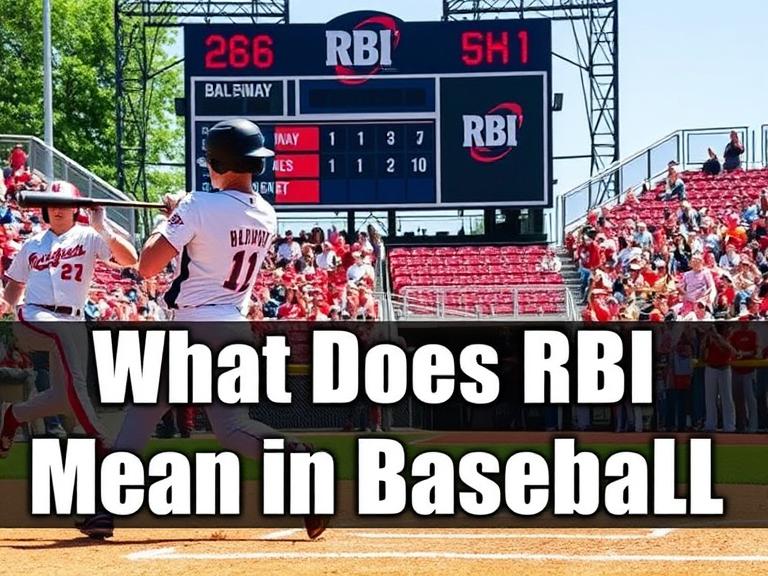What Does RBI Mean in Baseball? Baseball is filled with statistics that measure player performance, and one of the most important is RBI. If you’ve ever watched a game or checked a box score, you’ve likely seen this acronym. But what exactly does RBI mean in baseball, and why does it matter?
This article breaks down the definition of RBI, how it’s calculated, its significance in the game, and some common misconceptions. Whether you’re a new fan or a seasoned follower, this guide will help you understand one of baseball’s key stats.
Table of Contents
What Does RBI Stand For?
RBI stands for “Run Batted In.” It’s a statistic that credits a batter for directly contributing to a run scored by their team.
Simple Definition:
An RBI is awarded when a batter’s action (hit, walk, sacrifice fly, etc.) results in a runner crossing home plate.
How Is an RBI Earned?
A player receives an RBI in the following situations:
- Hit (Single, Double, Triple, Home Run)
- If a batter hits the ball and a runner scores, they get an RBI.
- Example: A batter hits a single, and a runner on third base scores.
- Sacrifice Fly or Sacrifice Bunt
- Even if the batter is out, if a runner scores, they earn an RBI.
- Walk (Base on Balls) or Hit by Pitch
- If a batter draws a walk with the bases loaded, forcing in a run, they get an RBI.
- Fielder’s Choice or Error
- If a run scores due to a defensive mistake or fielder’s choice, the batter may still get an RBI.
When Is an RBI Not Counted?
- Double Plays: If a run scores on a double play, the batter does not get an RBI.
- Wild Pitch or Passed Ball: If a runner scores due to a pitcher’s or catcher’s mistake, the batter is not credited.
- Batter Hits Into a Double Play (Unless a Run Scores Before the Second Out).
Why Is RBI Important?
RBIs measure a player’s ability to drive in runs, which is crucial for winning games. Historically, players with high RBI totals are considered strong offensive contributors.
Key Factors That Influence RBI Totals:
- Batting Order Position
- Cleanup hitters (4th spot) typically have more RBI chances because they bat with runners on base.
- Team Performance
- Players on high-scoring teams usually have more RBI opportunities.
- Clutch Hitting
- Some batters perform better with runners in scoring position.
RBI Leaders in Baseball History
Some of the greatest RBI producers in MLB history include:
| Player | Career RBIs |
|---|---|
| Hank Aaron | 2,297 |
| Babe Ruth | 2,214 |
| Albert Pujols | 2,218 (as of 2024) |
| Alex Rodriguez | 2,086 |
Active Leaders (2024):
- Albert Pujols (Retired, but holds the modern record)
- Miguel Cabrera (1,900+ RBIs)
Common Misconceptions About RBI
1. “RBIs Only Come From Hits”
- False. RBIs can come from walks, errors, and sacrifices.
2. “High RBI Totals Always Mean a Great Hitter”
- Not necessarily. A batter could have many RBIs simply because teammates get on base often.
3. “RBIs Are an Outdated Stat”
- While newer stats like OPS (On-base Plus Slugging) and WAR (Wins Above Replacement) provide deeper insights, RBIs remain a key traditional metric.
FAQs About RBI in Baseball
1. Can a batter get an RBI on a home run?
- Yes! A solo home run gives the batter 1 RBI, while a grand slam (bases loaded) gives 4 RBIs.
2. Who holds the single-season RBI record?
- Hack Wilson (1930) with 191 RBIs—a record that still stands.
3. Do RBIs count in All-Star or Playoff games?
- Yes, RBIs are tracked in all official MLB games, including postseason.
4. Can a player get an RBI without swinging the bat?
- Yes, via a walk, hit-by-pitch, or sacrifice fly.
5. What’s a “good” RBI total in a season?
- 100+ RBIs is considered excellent. League leaders often reach 120-140.
Conclusion
RBI (Run Batted In) is one of baseball’s oldest and most recognizable stats, measuring a player’s ability to bring runners home. While modern analytics provide deeper insights into player value, RBIs remain a key indicator of offensive production.
Understanding how RBIs work helps fans appreciate clutch hitting, lineup strategy, and player contributions. Next time you watch a game, keep an eye on RBI opportunities—they often decide close matchups!
Have more questions about baseball stats? Drop them in the comments! ⚾




